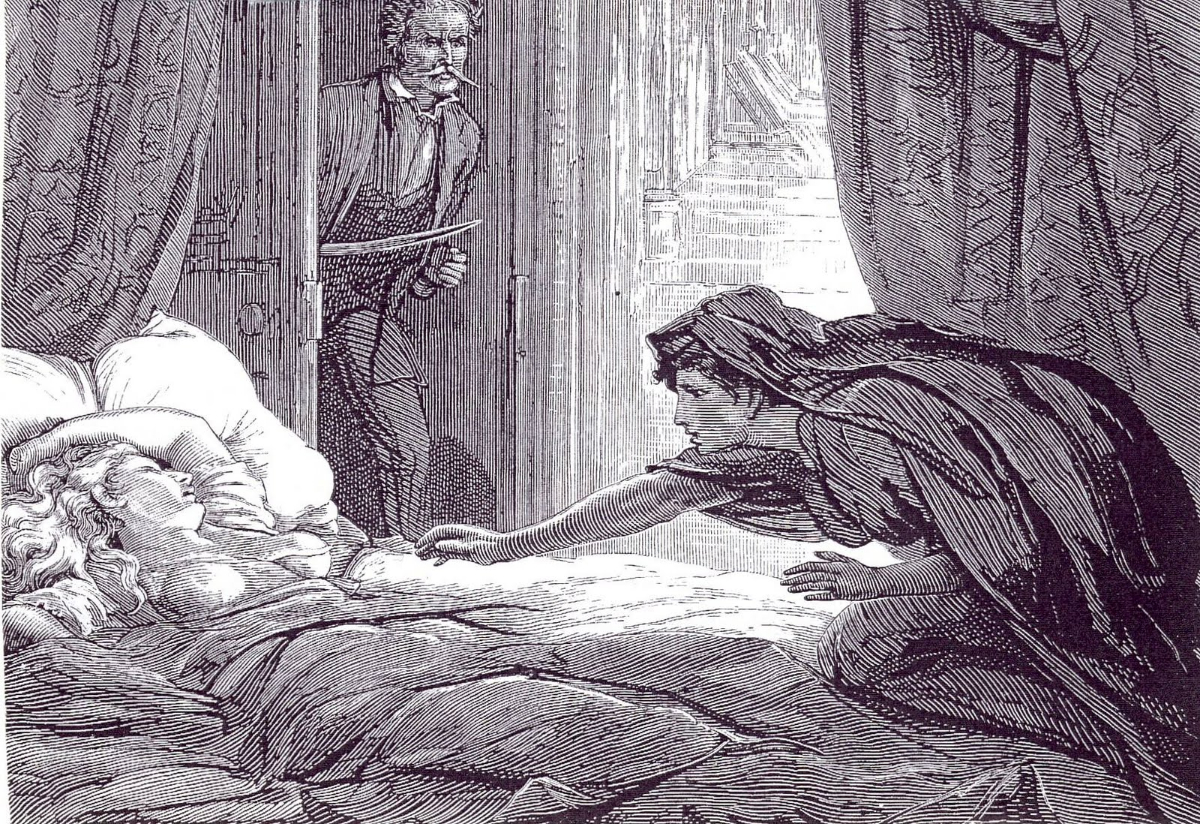The story is presented by Le Fanu as part of the casebook of Dr. Hesselius, whose departures from medical orthodoxy rank him as the first occult doctor in literature. The story is narrated by Laura, one of the two protagonists of the tale. Laura begins her tale by relating her childhood in a “picturesque and solitary” castle in the midst of an extensive forest in Styria, where she lives with her father, a wealthy English widower, retired from the Austrian Service. When she was six years old, Laura had a vision of a beautiful visitor in her bedchamber. She later claims to have been bitten on the chest, although no wounds are found on her. Twelve years later, Laura and her father are admiring the sunset in front of the castle when her father tells her of a letter he received earlier from his friend, General Spielsdorf. The General was supposed to bring his niece, Bertha Rheinfeldt, to visit the two, but the niece suddenly died under mysterious circumstances. The General ambiguously concludes that he will discuss the circumstances in detail when they meet later. Laura is saddened by the loss of a potential friend, and longs for a companion. A carriage accident outside Laura’s home unexpectedly brings a girl of Laura’s age into the family’s care. Her name is Carmilla. Both girls instantly recognize the other from the “dream” they both had when they were young. Carmilla appears injured after her carriage accident, but her mysterious mother informs Laura’s father that her journey is urgent and cannot be delayed. She arranges to leave her daughter with Laura and her father until she can return in three months. Before she leaves, she sternly notes that her daughter will not disclose any information whatsoever about her family, her past or herself, and that Carmilla is of sound mind. Laura comments that this information seems unnecessary, and her father laughs it off. Carmilla and Laura grow to be very close friends, but occasionally Carmilla’s mood abruptly changes. She sometimes makes unsettling romantic advances towards Laura. Carmilla refuses to tell anything about herself or her background, despite questioning from Laura. Her secrecy isn’t the only mysterious thing about her. Carmilla sleeps much of the day, and seems to sleepwalk at night. When a funeral procession passes by the two girls and Laura begins singing a hymn, Carmilla bursts out in rage and scolds Laura for singing a Christian song. When a shipment of family heirlooms, restored portraits, arrives at the castle, Laura finds one of her ancestors, “Mircalla, Countess Karnstein,” dated 1698. The portrait resembles Carmilla exactly, down to the mole on her neck.
| Alias Carmilla |
| Real Names/Alt Names Countess Mircalla Karnstein |
| Characteristics Vampire, Realism and Victorian Age |
| Creators/Key Contributors Sheridan Le Fanu |
| First Appearance “Carmilla” in The Dark Blue vol. 2 (Dec 1871) |
| First Publisher British & Colonial Publishing Co. |
| Appearance List Magazine: The Dark Blue (Dec 1871 – Jan 1872). Reprint: Le Fanu’s short-story collection In a Glass Darkly (1872). |
| Sample Read Carmilla [PG] |
| Description The story is presented by Le Fanu as part of the casebook of Dr. Hesselius, whose departures from medical orthodoxy rank him as the first occult doctor in literature. The story is narrated by Laura, one of the two protagonists of the tale. Laura begins her tale by relating her childhood in a “picturesque and solitary” castle in the midst of an extensive forest in Styria, where she lives with her father, a wealthy English widower, retired from the Austrian Service. When she was six years old, Laura had a vision of a beautiful visitor in her bedchamber. She later claims to have been bitten on the chest, although no wounds are found on her. Twelve years later, Laura and her father are admiring the sunset in front of the castle when her father tells her of a letter he received earlier from his friend, General Spielsdorf. The General was supposed to bring his niece, Bertha Rheinfeldt, to visit the two, but the niece suddenly died under mysterious circumstances. The General ambiguously concludes that he will discuss the circumstances in detail when they meet later. Laura is saddened by the loss of a potential friend, and longs for a companion. A carriage accident outside Laura’s home unexpectedly brings a girl of Laura’s age into the family’s care. Her name is Carmilla. Both girls instantly recognize the other from the “dream” they both had when they were young. Carmilla appears injured after her carriage accident, but her mysterious mother informs Laura’s father that her journey is urgent and cannot be delayed. She arranges to leave her daughter with Laura and her father until she can return in three months. Before she leaves, she sternly notes that her daughter will not disclose any information whatsoever about her family, her past or herself, and that Carmilla is of sound mind. Laura comments that this information seems unnecessary, and her father laughs it off. Carmilla and Laura grow to be very close friends, but occasionally Carmilla’s mood abruptly changes. She sometimes makes unsettling romantic advances towards Laura. Carmilla refuses to tell anything about herself or her background, despite questioning from Laura. Her secrecy isn’t the only mysterious thing about her. Carmilla sleeps much of the day, and seems to sleepwalk at night. When a funeral procession passes by the two girls and Laura begins singing a hymn, Carmilla bursts out in rage and scolds Laura for singing a Christian song. When a shipment of family heirlooms, restored portraits, arrives at the castle, Laura finds one of her ancestors, “Mircalla, Countess Karnstein,” dated 1698. The portrait resembles Carmilla exactly, down to the mole on her neck. |
| Source Carmilla – Public Domain Super Heroes Wiki |


